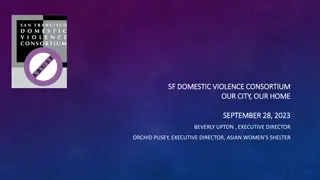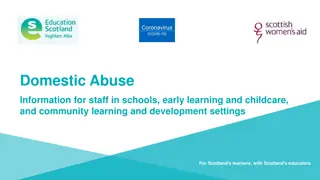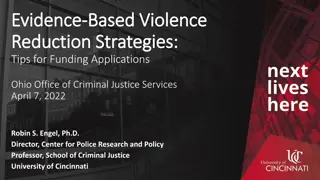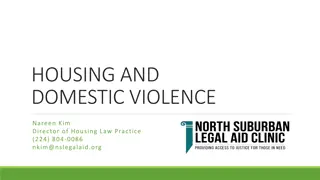Understanding the Impact of Domestic Violence on Children and Families
Child care providers play a crucial role in identifying and supporting children exposed to domestic violence. The facts and statistics reveal the prevalence of abuse and its traumatizing effects on young children. By being aware and prepared, providers can help contribute to the healing and safety of families affected by domestic violence.
Download Presentation

Please find below an Image/Link to download the presentation.
The content on the website is provided AS IS for your information and personal use only. It may not be sold, licensed, or shared on other websites without obtaining consent from the author. Download presentation by click this link. If you encounter any issues during the download, it is possible that the publisher has removed the file from their server.
E N D
Presentation Transcript
THE ROLE OF CHILD CARE PROVIDERS In partnership with the Missouri Department of Health and Senior Services and your local public health agency Child Care Health Consultation Program
Melrose Alliance Against Violence info@maav.org 235 West Foster Street Melrose, MA Institute for Safe Families, Philadelphia PA www.instituteforsafefamilies.org
Often a combination of physical, sexual, and/or emotional abuse --behaviors and actions are violent and abusive Many abusive parents think that young children (infants and toddlers) do not understand and will not remember or be seriously impacted by family violence This means that significant numbers of children under age five will be exposed
This is why it is important for providers in all early childhood settings to be aware, and prepared to respond to children who may be experiencing domestic violence As providers, you are uniquely positioned to support children and families through the trauma of domestic violence and to contribute to family coping, safety and healing
Men can be the victim of domestic abuse, but abuse is predominantly committed against women (5 to 8 times more often) 1 in 3 adult women will be assaulted by a partner during their adulthood Half of victims who got an order of protection were abused again within the next two years
3 to 10 million children are exposed to violence by family members against their mother or caretaker yearly In these homes, children are 1500 times more likely to be abused themselves
The Cost of Domestic Abuse: Annual medical expenses from domestic abuse total at least $3 to $5 Billion Another $100 million is lost in sick leave, absenteeism, and non-productivity
Pushing, slapping, kicking, punching Throwing objects Threatens or injures with a weapon Controls when they can or can t go out Withholds necessary items (food, clothes) Destroys property Threatens family members Abuses children Refuses to seek medical care for the partner
Treats partner as a sex object Forces sex after a beating May withhold affection Extreme jealousy; accusations of affairs Forces nudity Forces watching of pornography Commits cruel sex acts
Continual criticism, yelling, insulting Ignores feelings Ridicules most valued beliefs Withholds affection as punishment Doesn t share financial responsibilities, but controls finances Uses lies to manipulate Insults friends & family to keep them away; won t socialize Harasses partner at work Humiliates in public places Threatens to leave or throw partner out Threatens to take kids Punishes or deprives kids to punish partner
Extreme jealousy Controlling behavior Unrealistic expectations Blames others for problems/feelings Verbal abuse Abuses animals or children Threats of violence Breaking or striking objects Force used during arguments Jekyll and Hyde personality MORE THAN THREE = STRONG POTENTIAL FOR ABUSIVE RELATIONSHIPS
Why do victims stay in abusive relationships? Fear Victims fear the physical harm that might come if they attempt to leave. Love Victims may truly have deep feelings for the abusive partner. Promises Promises that this abuse will never happen again. Abuse = Love Confusion between being loved and being controlled by their partner. Guilt Being made to think that the abuse is their fault, that they have the problem.
Not Being Believed A strong fear nobody will believe them if they speak out Thinking They Can Change Them The belief that over time the victim can change the abusive partner. Low Self-Esteem feeling that they can do no better than their current relationship. Being Alone could mean a loss of mutual friends, relatives and others associated with the relationship. Financial Money, children and no place to go also hold victims in these relationships.
Childrens reactions to traumatic events will include their own individual experience of the event (what they saw, what they heard, etc.) and the crisis reactions they witness in the adults around them (parents, teachers, neighbors, police, etc)
PRE-SCHOOL: Ages 2-6 years Aggressive behavior, hyperactivity Anxiety about separation from parent or other caretaker Silence, withdrawal from others Regression: may refuse to feed, dress, wash self, may lapse in toilet training, bedwetting Sleep disturbance, nightmares; fears of darkness, monsters , strangers Physical: loss of appetite, vomiting, diarrhea, nervous tics Re-enactments/play about the recent event Inability to understand death and its permanency (child may talk about return of deceased) Increase in anxiety, insecurity with changes in routine
EARLY CHILDHOOD: Ages 6-10 years Behavioral changes may occur either quieter, lethargic, withdrawn, or active, noisy Fantasies about traumatic event with savior ending Regressive reactions including excessive clinging, crying, whimpering, wanting to be fed or dressed Complaints of headaches, stomach aches, nausea, persistent itching, scratching Sleep disturbance, nightmares, night terrors, bedwetting Irritability. Disobedience School phobia; inability to concentrate with drop in school achievement Competition with siblings for parental attention Decreased trust in adults Displaced fears, (not feeling safe in place where there s no immediate threat)
PREADOLESCENT: Ages 11-14 years Anger at unfairness of event More childlike in attitude Disruptive behavior; resistance to authority Increased difficulty relating to siblings, teachers, parents Loss of interest in peer activities Psychosomatic illness such as: headaches, complaints of vague aches, overeating or lack of appetite, stomach aches, bowel problems, skin disorders Sleep disturbances including excessive sleep Judgmental about own behavior especially when close connection to violence or trauma Anti-social behavior (lying, stealing) Sadness or depression; may believe existence is meaningless Drop in level of school performance, attendance Alcohol, drug abuse High risk behaviors including unprotected sex
Early experiences become biology, changing brain chemistry, thus shaping the way people learn, think, and behave for the rest of their lives. Resilience in young children depends on protective factors, such as relationships and attachments; skills, competence, and confidence; and faith and meaning in life. The adults in children s lives can support their level of resilience by caring, providing a supportive environment.
ROLE OF CHLD CARE PROVIDERS
It is important that early childhood care and education providers develop a core of knowledge about trauma and the effects of trauma on young children their role is to bring to their directors attention all child behavior that is problematic or concerning
Early childhood program staff members are not qualified to diagnose Post Traumatic Stress Disorder, ADD, ADHD, or any other mental and/or emotional condition. These conditions are very similar and early care and education providers need to confer with and refer to mental health professionals for evaluation.
Everyone reacts to risk factors in a personal way--think about the level of damage risk factors might have caused them or their families. Studies have shown that it is the layering or "accumulation" of risk over time that causes the most difficulty and harm to children. If young children experience multiple risks without adequate resources to cope, it could result in cycles of failure and enduring trauma.
Scenarios: 1. Parent talks about a domestic violence situation in her home to child care center director. 2. Child comes to center with facial bruises. Child tells teacher that she was accidentally hit by her father while her parents were arguing. 3. Teacher witnesses a child s father hitting his wife in the childcare center parking lot. The child was still inside the center and did not see it. 4. Child role plays parent arguing and hits another child while engaged in dramatic play in the doll corner. 5. Child tells staff member that she saw her mom hitting her grandmother and staff knows that the grandmother is ill and lives with the child.
Legal requirements (whether there is mandated reporting in each case) Policies of child care/preschool program Professional ethical standard Consequences of disclosure/non- disclosure To the child? To the parent/ provider relationship? How/with whom parent wants information shared
Check your personal attitudes and perceptions Keep yourself safe Focus on the needs of the child Know the plan or steps recommended by your agency (including legal requirements) Consult with a supervisor Refer a family/child to local counseling services Refer a victim to a domestic abuse specialist at a local agency
The possibility of encountering domestic violence in early childhood programs is one of the most difficult and troubling aspects of working with young children. This training is an introduction to background information and tools for responding to a child or family living with domestic violence. Program staff would need more training to develop policies and practices that support them to become effective responders
The early childhood environment can be comforting and healing for children living with domestic violence and a resource for their parents. Staff members who can access resources, seek support and supervision, and nurture themselves will be uniquely positioned to create the environment of hope and caring outlined in this training
www.acestudy.com A comprehensive study of adverse childhood experiences on adult health and mental health www.childtrauma.org The Child Trauma Institute provides training, consultation, information, and resources for those who work with trauma-exposed children, adolescents, and adults.
www.instituteforsafefamilies.org CHANCE curriculum & resource manuals: developed by Caregivers Helping to Affect and Nurture Children Early, Institute for Safe Families, Philadelphia, PA























